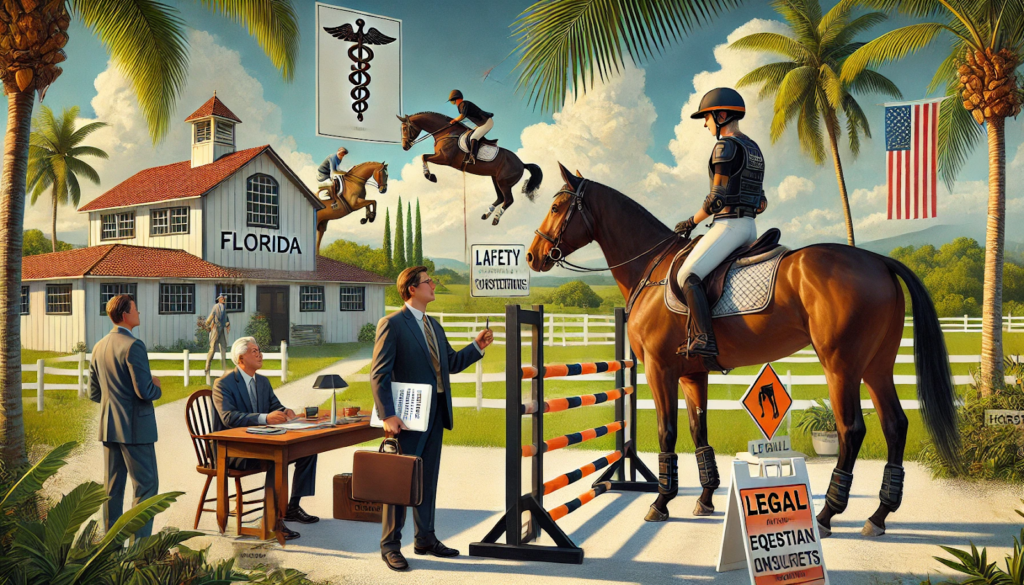Florida’s equestrian culture offers breathtaking experiences, from scenic trail rides to competitive equestrian events. Amidst the beauty and thrill of horseback riding, legal considerations for horse riding injuries are paramount. Understanding the legal landscape can significantly influence how riders and equine professionals navigate potential liabilities.
In Florida, specific laws govern the responsibilities and protections related to equine activities. For instance, the state’s equine liability statute limits the liability of equine professionals and sponsors if an injury results from inherent equine risks. However, there are exceptions to this protection, particularly in cases of negligence. The new law signed to mandate helmets for riders under 16 highlights the importance of safety measures to prevent severe injuries.
Florida Statute 773.01-02 exempts these individuals from liability for injuries due to the inherent risks of equine activities. However, there are noteworthy exceptions. According to Section 773.03, liability can arise in cases of known hazards or negligence.
Riders should also be aware of the possibility of seeking compensation for injuries. Consulting personal injury attorneys can provide guidance on the necessary steps in the event of an accident. Given the potential risks associated with horseback riding, it’s crucial for participants to stay informed about their rights and legal protections.
Understanding Equine Liability in Florida
Florida’s equine liability laws outline the responsibilities and protections for those involved in horse-related activities. These laws detail the concept of equine liability, the role of activity sponsors, and the legal protections available to both professionals and participants.
Concept of Equine Liability
In Florida, equine liability focuses on limiting the responsibilities of certain parties for injuries arising from the inherent risks of horse-related activities. Under the Equine Activity Liability Statute, an equine activity sponsor, an equine professional, or any other person is not liable for injuries or death resulting from such inherent risks.
These inherent risks include behaviors such as biting, stumbling, or unpredictable movements by horses. The law specifically enumerates several exceptions to this limitation, such as when faulty equipment is knowingly provided or when a sponsor or professional does not reasonably ensure safety measures.
Role of Equine Activity Sponsors
Equine activity sponsors in Florida play a significant role in managing and overseeing horse-related events. These sponsors are shielded from liability for participant injuries caused by the inherent risks of equine activities under statutory protections.
Sponsors are mandated to display a clear warning notice that informs participants about these risks. This notice must be prominently posted where activities occur and included in contracts and releases. Despite these protections, sponsors may still be liable if they fail to address known hazardous conditions or provide faulty tack and equipment.
Legal Protections for Professionals and Participants
Equine professionals, such as trainers or instructors, are also afforded specific legal protections under Florida law. These protections are designed to mitigate personal injury claims arising from the inherent risks of equine activities. However, professionals must fulfill their duty of care by ensuring safe practices and maintaining reliable equipment.
Participants, on the other hand, assume the inherent risks associated with horse riding. They are expected to exercise their judgment and follow safety guidelines provided by the professionals. The statute underscores that liability limitations do not apply if the professional’s negligence directly causes an accident or injury.
By setting forth these comprehensive measures, Florida aims to balance the interests of equine industry stakeholders while promoting a safe environment for horse-related activities.
Practical Aspects of Horse Riding and Injury Mitigation
Managing the risks associated with horse riding involves not only proper safety measures and training but also meticulous attention to equipment and facility maintenance. Equine behavior plays a critical role in preventing injuries, requiring riders to be well-informed and responsive.
Safety and Training Considerations
Proper training is essential for reducing the risks of horse riding injuries. Participants should have a formal and structured training program that emphasizes both riding skills and handling techniques. Instructors should be certified and experienced, ensuring they can teach riders how to anticipate and manage the unpredictability of horses.
Riders must wear appropriate safety gear, such as helmets and protective vests, to minimize harm during falls or collisions. Training also includes teaching riders how to read and respond to the horse’s behavior, as understanding these cues can prevent dangerous situations. Regular safety drills and reviews of emergency procedures are vital components of a comprehensive training program.
Equine Riding Equipment and Facility Maintenance
Faulty or poorly maintained equipment can significantly increase the likelihood of injuries. Ensuring that tack, like saddles and bridles, is in good condition is crucial. Regular inspections should be conducted to identify and repair any issues with the equipment.
Facilities, including stables and riding arenas, must be well-maintained to provide a safe environment. Proper lighting, clean and clutter-free areas, and stable surfaces are crucial for reducing accidents. Warning signs should be clearly posted to highlight any potentially dangerous conditions or hazards, such as slippery surfaces or low-hanging obstacles, ensuring that riders are aware and can take appropriate precautions.
Understanding and Responding to Equine Behavior
A thorough understanding of equine behavior is indispensable for any rider. Horses are inherently unpredictable animals, making it essential for riders to recognize signs of distress, fear, or aggression.
Proper training on how to handle these situations can prevent many accidents. Riding experience plays a key role in this area, as seasoned riders are generally better at maintaining control over their horses. Engaging safely with the horse requires continuous observation and adaptation to the horse’s actions and reactions.
By fostering a strong bond and mutual trust between rider and horse, the chances of experiencing dangerous situations decrease significantly, creating a safer riding experience for all involved.
Read More: High-Speed Connectivity: Fiber Optic Installers Transforming Atlanta Businesses
